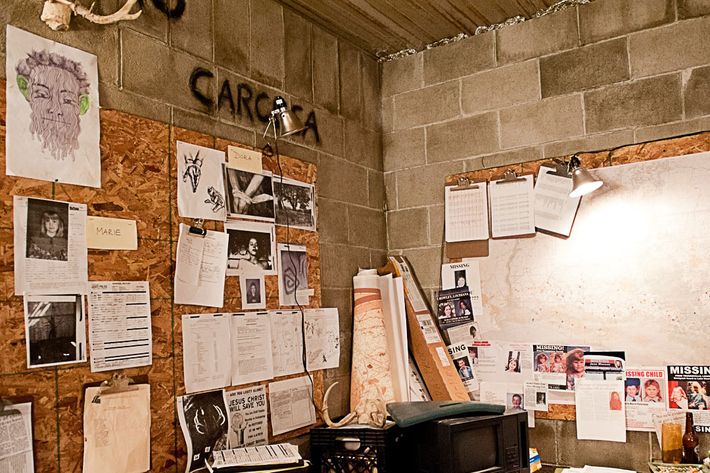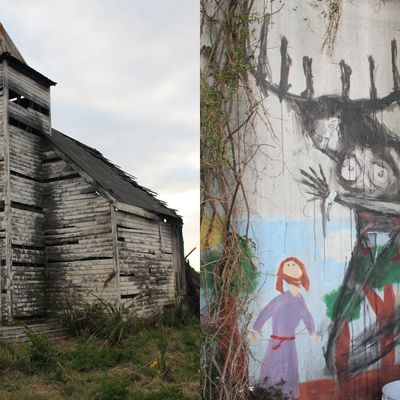
To help create the backwoods Louisiana noir of HBO’s True Detective, season-one director Cary Fukunaga recruited Alex DiGerlando, the production designer behind the haunting half-sunken bayou depicted in Beasts of the Southern Wild. Fukunaga had previously worked on a short film made by Beasts director Behn Zeitlin that was also set in a southern Delta community in the aftermath of a flood. Vulture spoke with DiGerlando about how he pulled off the detective drama’s haunting atmosphere, and asked him to walk us through behind-the-scenes photos of 13 exceptional props and set pieces.
The Devil’s Nests
All of the show’s artwork — from the twig sculptures known as devil’s nests to the church paintings — was created by Joshua Walsh, an artist from Detroit who had spent 20 years working in New Orleans. “He’s the son of a family that ran a funeral home, and he’s an avid hunter and taxidermist — basically, the perfect dude for the job,” DiGerlando told Vulture. Walsh worked full-time for nine months creating over 100 pieces for the show.
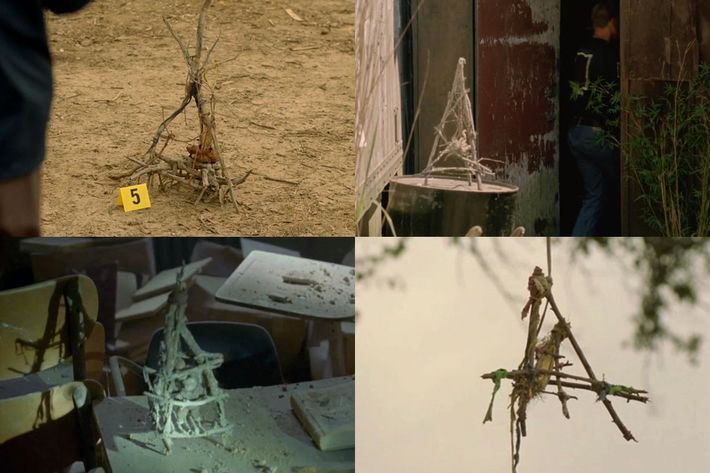
According to DiGerlando, there was very little detail about what a “devil’s nest” should look like in the script. Pizzolatto’s rough guidelines specified that they should have a spiral motif and be able to stand on their own. “They were described as sort of watching over that first crime scene,” DiGerlando said. They decided on a tripod structure, which, if laid on its side, would have a spiral naturally build in from the bottom. “We were also told all of this artwork is the killer’s way of ascension to reach this spiritual plain that he has in his mind,” DiGerlando said. “Thus, the ladder aspect. You’ll notice a lot of the tripods have cross-members going up the sides.” Not all of them, though. No two look the same. They show up throughout the series at the girl’s playhouse, the abandoned school, the Ledoux meth compound, “and for reasons best not to get into, we wanted subtly different looks for each of those settings. It wasn’t as simple as making an assembly line for them. Josh Walsh designed each one for each specific set.”
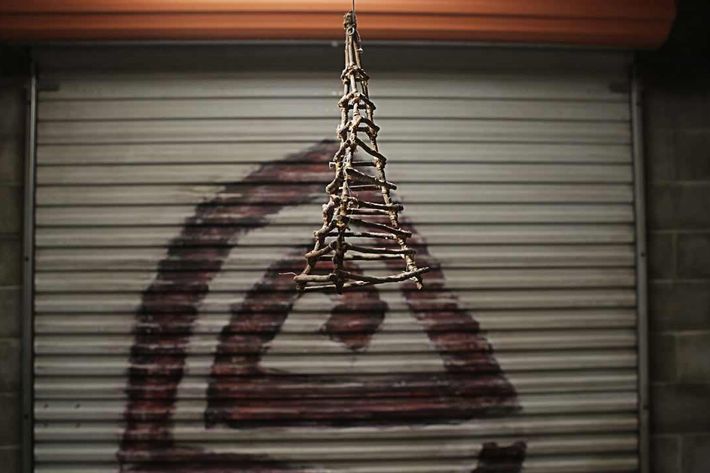
DiGerlando found Walsh by chance. For inspiration, DiGerlando had already pulled the art of primitive and voodoo cultures, and of outsider artists Henry Darger and James Castle, when he spotted a small hummingbird sculpture made by Walsh on the desk of set decorator Cynthia Slagter. It was made of twine and sinew and reeds and little sticks, which matched up with DiGerlando’s vision for the killer’s art. “We wanted it to have a primitive, primal feeling,” he said. “He isn’t a person who went to art school. He’s a person who has some deep inner urge to express himself, and he does it through these murders and these constructions. Josh went very Method and made most of the pieces using the materials he thought this guy would use: mud, ripped-up pieces of children’s clothes that he bought at thrift stores, roots. He’d wander through the marsh on shopping expeditions.”
The Crime Scene
In the series premiere, Hart and Cohle find the slain body of a prostitute, who had been tied up, raped, mutilated, and crowned with deer antlers, in a scorched sugar field outside of Erath, Louisiana.
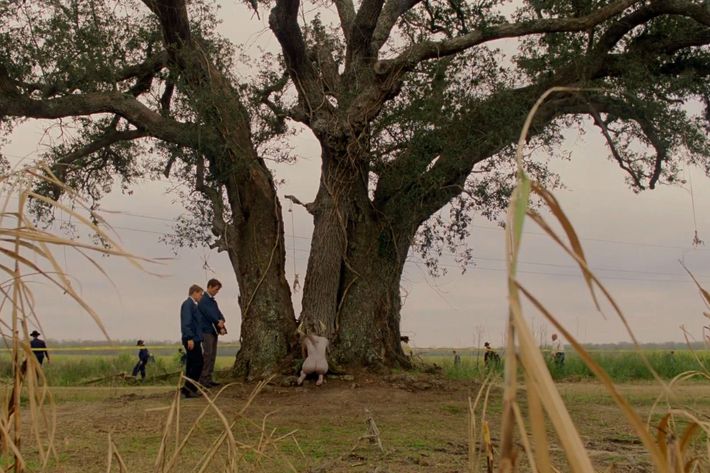
In the original script, the detectives find Dora Lange’s corpse bent over in prayer in the woods with wings attached to her back. The first thing to go were the woods. “There aren’t great woods in Louisiana. It’s more of a swamp,” DiGerlando said. Production swapped in a particularly striking sugar cane field that he had scouted for the finale (which no longer takes place there). “They were burning the fields to clear them at the time, and it was so moody and atmospheric setting for this bizarre altar.” Pizzolatto replaced the wings with antlers for an equally pragmatic reason. “There was something else he remembered that used wings. I think it was Red Riding,” DiGerlando said. “It was always written that she was in a kneeling position, though, praying toward the tree, and there were always three of the twig sculptures standing by looking over her.”
The Spirals
You see them everywhere. The bird formation. On the back of Dora Lange. In the freshly mowed grass. There’s just one place that a spiral made an accidental appearance …
DiGerlando can’t say too much about the story behind the spirals — though we can assume they’re all wrapped up in Cohle’s metaphysical monologues. (“This is a world where nothing is solved,” Cohle says in the 2012 timeline. “Someone once told me time is a flat circle. Everything we’ve ever done or will do, we’re gonna do over and over and over again.”) They’re all associated with the killer. Pizzolatto drew a spiral image himself, and Walsh refined the final irregular shape by taking a wire clothing hanger and twisting it into a spiral. “The idea being these guys — the killer and the LeDoux brothers — would use it as a branding tool,” DiGerlando said.
For those tracking the appearances of the spirals, you can cross off the one you found in Hart’s house. That was a mistake. “I didn’t even notice that one,” DiGerlando said. “We got a whole bunch of artwork from the daughter of a friend of mine down the street and used it to decorate Marty’s house. None of us put it together that there was a spiral in there.”
Cohle’s Empty Apartment
White walls, a mattress, a cross. Cohle: “That’s a form of meditation.” Hart: “How’s that?” Cohle: “I contemplate the moment in the garden, the idea of allowing your own crucifixion.”
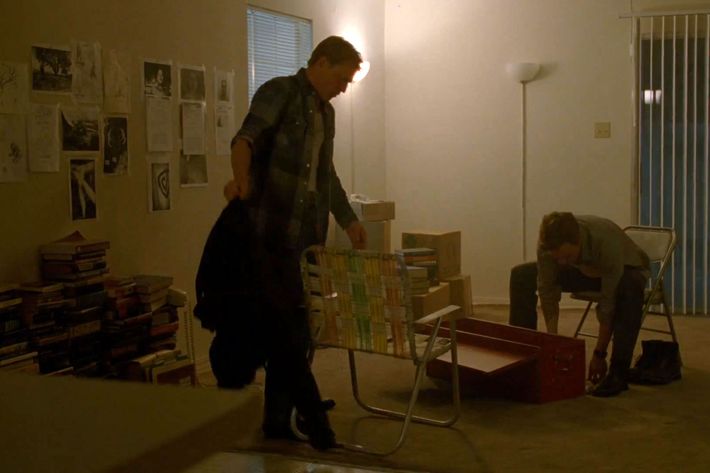
DiGerlando and Fukunaga set out to find a place similar to where McConaughey’s character in Dallas Buyers Club lived. “Like a fleabag motel,” DiGerlando said. “But as we were looking, we realized two things. One, we have a lot of that kind of stuff in the show anyway, and two, it didn’t seem to make sense that a detective, as crazy or as self-destructive as Rust may seem, would live in such a disgusting place.” They went in the opposite direction: spartan style. “It’s no more and no less than what he needs to survive, and that tells you everything you need to know about him. He doesn’t need anything extraneous.” They wound up jettisoning nearly everything from the room, including a sofa bed, a box spring, a nightstand. “It pays off later on when Maggie shows up and you see him by himself flashing his flashlight at the antlers, trying to figure it out,” DiGerlando said. “He doesn’t want the distraction of anything else. The case is where he lives. That is, he lives in his own mind and there’s nothing extraneous in there.”
The Beer-Can Men
They’re a motif that runs throughout Pizzolatto’s work. “I think they show up in his novel, too,” DiGerlando said. “You’d have to ask him where it comes from.” Getting the look just right took some experimenting. It had to be someone McConaughey could do with ease while spouting Cohle’s bleak worldviews. Pizzolatto had described the men as having lids for heads, but that didn’t work. “We found that it looked a little goofy, almost too comical, DiGerlando said. “We had cut the rim off the top of the can and folded it up so the hole where you’d drink from became the mouth. It looked like Edvard Munch’s The Scream, with this big head bobbing around.”
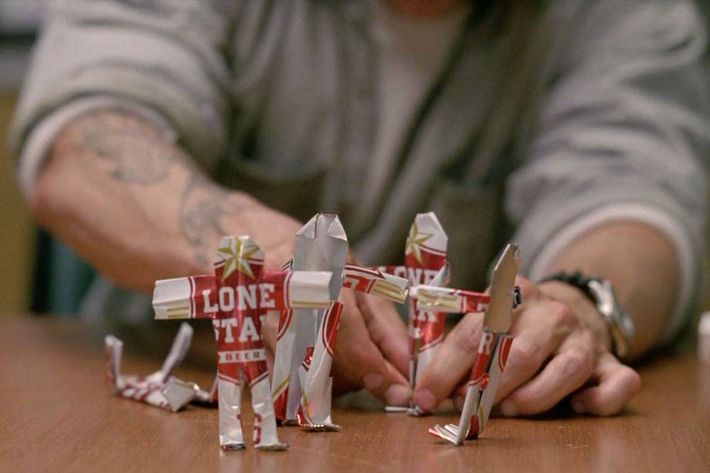
Another version used two cans for every one man. Like Cohle’s apartment, they wound up stripping it down to the most minimal figure. As for using Lone Star, DiGerlando said they were the brand game to let their beer cans be used for purposes other than drinking. “It was just serendipitous that it happened to lend itself to the way the star lays out on the beer-can men,” he said.
The Burned-Down Church
At the end of episode two, Hart and Cohle arrive at the torched remains of Pastor Theriot’s (Shea Whigham) old church. DiGerlando’s team built it from scratch near the Bonnet Carre Spillway, also seen in Beasts of the Southern Wild.
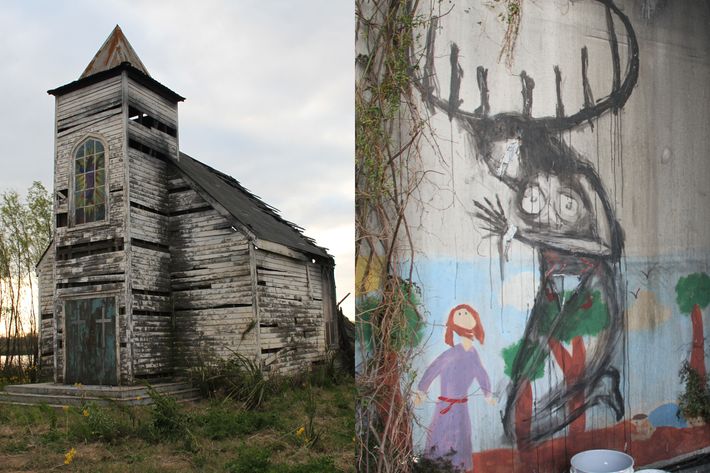
“Because of the lack of burnt-down churches available to us, we knew were going to have to build that,” DiGerlando said. The challenge was in finding the right piece of land, which needed to be off the beaten track — so that Hart and Cohle would have to follow their leads to it — but near a road. They settled on the not-so-accommodating patch behind the spillway. “You had to get to it by driving down a service road over a levee, down a mud road, and then we even had to drop down gravel to make it reachable. There was a lot of, Is this worth it?” DiGerlando laughed. “But we all loved the location, having the water and all those refineries in the distance, and the train tracks. What luck to be able to get that shot with the train going by as they pull up. And having that natural brush hitting the church? The approach to the church looked excellent.” The church itself took a month to build. They kept a fire going throughout to char the wood they used to built the skeletal back of the building.
Inside the church, they brought back Ella Densen — the same 7-year-old who produced the artwork of Marty’s daughters — to do the Biblical scenes found on the walls. The script specified David and Goliath and Jesus and the leper, among others. Later, Walsh came in to paint the girl with antlers on top of Ella’s work, which he produced using the leftover charred wood as smudge sticks. “There’s a lot going on,” DiGerlando said. “If you stopped and looked, you’d see his artwork on top of hers and then the greens and vines over that, and the idea being a couple months prior to the detectives’ arrival, the church burned down and the killer at some point showed up and left his mark.”
The Offices of the Louisiana State Criminal Investigations Division
It’s the only set seen in every episode. The interior had to be re-dressed often as the narrative bounced back and forth between 1995, 2002, and 2012.
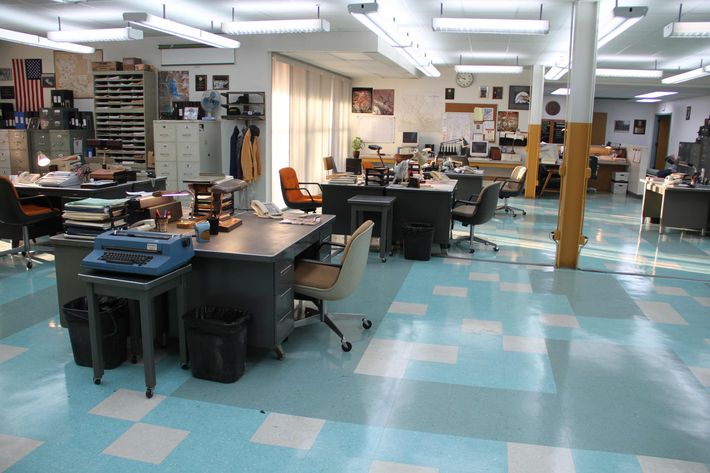
“One of the biggest challenges we designed, one of the most important in the show even though people probably don’t think about it, is the room they’re being interrogated in in 2012,” DiGerlando said. It’s a conference room in 1995 that gradually becomes more of a storage area, which is why boxes and typewriters hang out in the background when Hart and Cohle are being interrogated later on. “It was a lot of moving old computers out and new computers in, hiding and displaying wires for IT,” he said. “We built all of it: the evidence room Marty breaks into, the turquoise checkered flooring, all of it.” The offices are set inside an old lightbulb warehouse in Elmwood, Louisiana. “It had a dated architectural look, dated for even 1995, with this pebbled texture, these interesting skinny windows with arched tops, and this fantastic lobby with the free-floating staircase,” DiGerlando said. “We wanted it to not look like it was new in 1995.
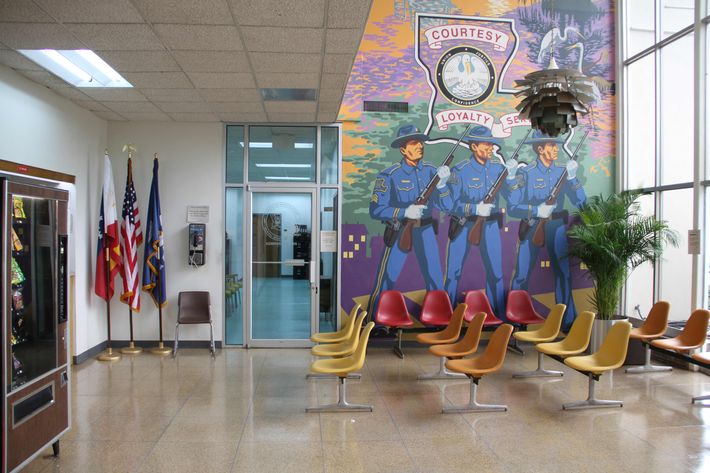
Cohle’s Big Hug Mug
“I had nothing to do with it,” DiGerlando laughed. Prop master Lynda Reiss brought several options for the cheesy mug, and Fukunaga picked the big hug. “It’s the one prop Cary wanted to keep,” he said. “I’m so pissed I didn’t go on eBay before the show aired and not buy up a bunch of those. They’re worth a small fortune now.” There’s no secret message hidden there, either, though DiGerlando said they did look for any opportunity to insert some levity into the show, “because it is relentlessly dark.”

Pastor Theriot’s Tent Revival Church
In the beginning of episode three, “The Locked Room,” Hart and Cohle find the pastor preaching in his new church (“This world is a veil, and the face you wear is not your own,” Theriot says) made out of a tent top and decorated with painted-on scripture verses. “This was one of my favorites,” DiGerlando said.
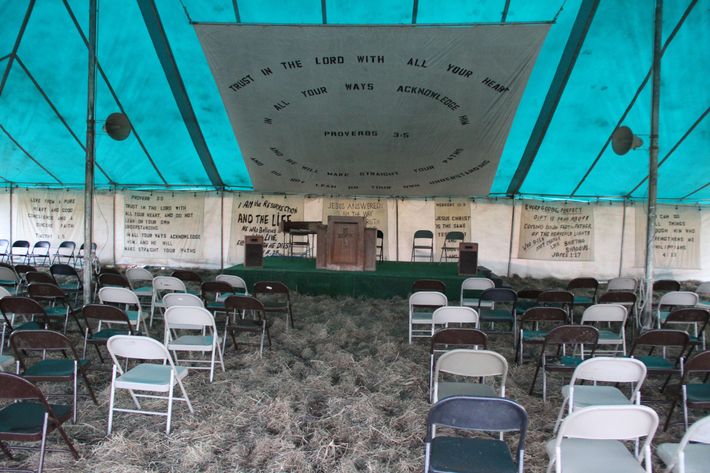
Many of the revival tents DiGerlando found in his research were striped, which felt too much like a circus, so he opted for a plain one with a big ol’ cross on top. He found a company that made them, but had to create a 3-D model of the tent to figure out how big they could make the cross and have it fit in the frame with Pastor Theriot mid-sermon. Scenic artists came to “dirty up” the fabric and draw in the words as though they were hand-done by the congregation. “The tent revival feels a bit lost in time,” DiGerlando said. “You don’t see them as often, and there’s a sadness to it which I really liked.”
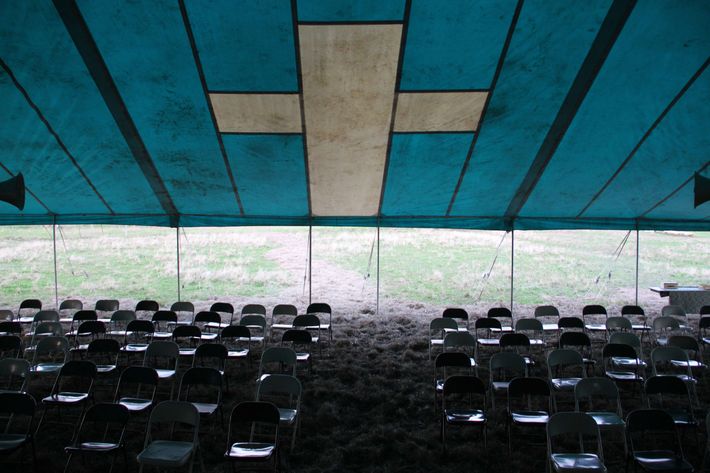
The Abandoned School
At the end of episode five, Cohle revisits the devastated school once attended by Rianne Olivier. He and Marty never got to investigate it because of a last-minute lead on Ledoux. He goes back to explore and finds it decked out with Mary statues, devil’s nests, and the creepiest cherub paintings ever.
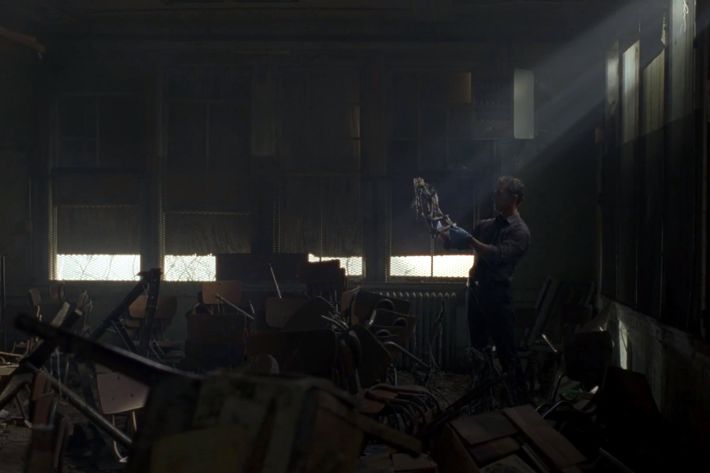
The piles of desks were already at the old Kenner High School in New Orleans, one of the few show-stopper sets DiGerlando was fortunate enough to find. “We sculpted the desks to make a maze for Rust to walk through, leading him to the reveal of the devil nest sculptures. We wanted them to feel like they were sitting there, as if they were students in the classroom,” he said. “They kind of reminded us of these photographs Robert Polidari took of Chernobyl.” Walsh came back to paint the scary “see no evil, hear no evil, speak no evil” cherubs on the wall. “You can really see when he picks up that devil’s nest and looks from the bottom how it has that spiral effect.”
Beth’s Apartment
The young prostitute Hart encouraged to leave the bunny ranch in 1995 resurfaces in 2002 (episode six, “Haunted Houses”) with a new job, her own place, and her sights set on Hart.
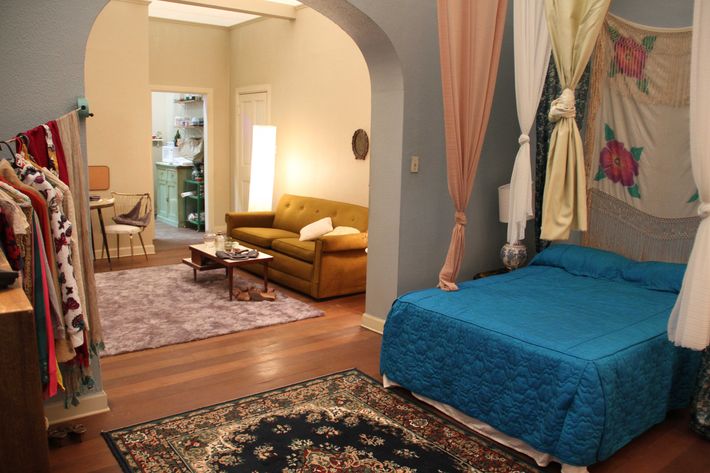
“A lot of these characters are so damaged and living in very desolate living situations, and Beth (Lili Simmons) is a character who actually pulled herself out of a not so great situation,” DiGerlando said. To that end, he made her apartment in 2002 a kind of extension of Jan’s trailer at the bunny ranch where Beth worked. “We tried to make that trailer a little homey, add some feminine qualities to make it … more a shade of gray than just the place where this horrible madame exploits these girls. There’s dialogue in the scene to that effect, that there’s more to it than Marty would think,” DiGerlando said. “We wanted to make sure Beth had some dimension and a real interior life. Her apartment had to be a place she’d walk in and say, ‘This is my home.’ She’s got a straight job, she’s going to want something nice, and we interpreted that to mean not a cookie-cutter apartment.” To give it some character, he added an arch, put up floral wallpaper, gave it an odd stucco texture, and created a DIY canopy bed that DiGerlando had spotted on a scouting trip made of blankets and old dresses.
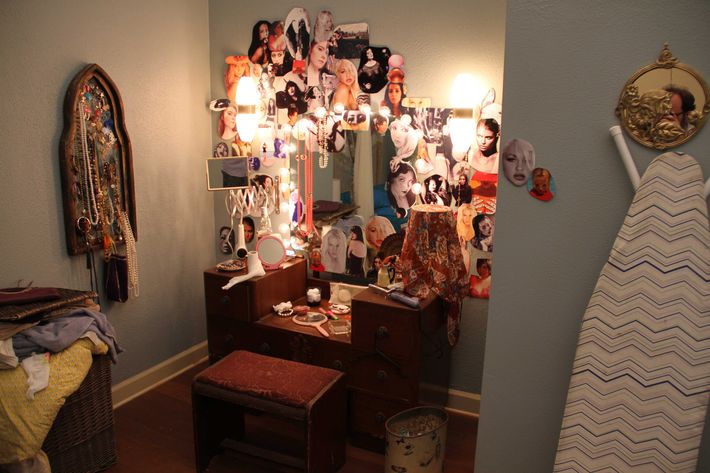
The Ledoux Cousins’ Meth Compound
We first see Reggie Ledoux briefly at the end of episode three on his meth compound wearing a jockstrap and gas mask. Hart and Cohle don’t get a good look at the place until two episodes later in “The Secret Fate of All Life,” when Marty makes a horrifying discovery and kills Ledoux.
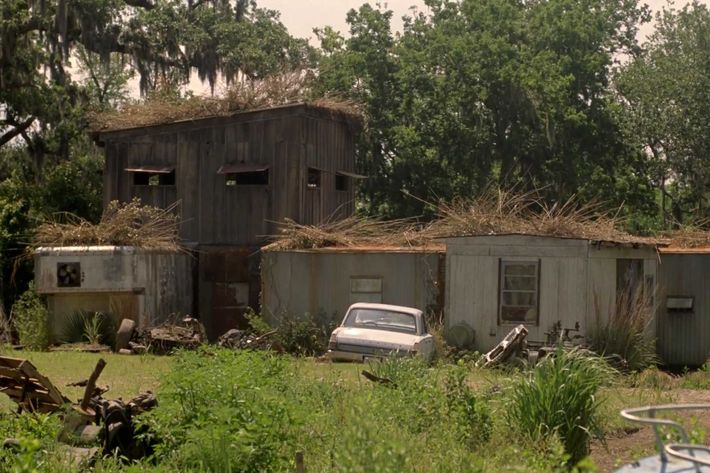
DiGerlando wanted a Frankenstein setup for the compound: a found trailer as their shack, a shipping container to serve as the lab (“We dressed that whole lab and unfortunately, you don’t get to see it,” he said), a deer blind structure in the back, wrecked cars, barrels, and devil’s nests all over the place. “The shack itself had to have a mazelike quality so Marty and Ledoux can cross paths in that one moment without Ledoux realizing,” he said. But the most important detail for DiGerlando was the locked room in which the children were being hidden. “I knew early on I wanted to use the cube from a cube truck for that,” he said. “The way it unlocks, I knew there’d be drama in that.”
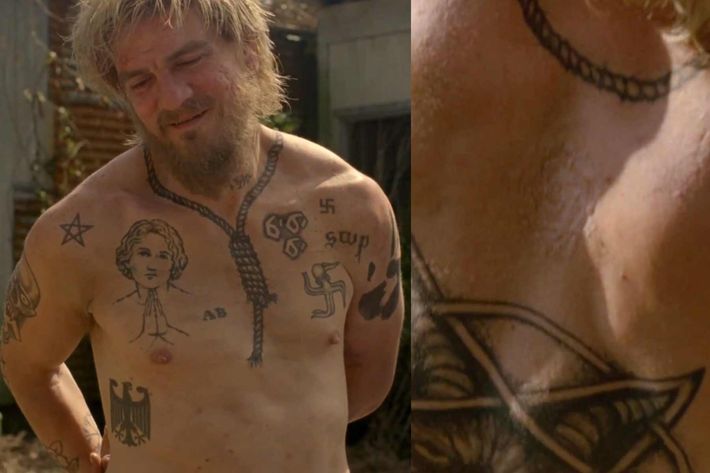
Cohle’s Storage Unit
Turns out Rust’s even more obsessed with the case than we thought! DiGerlando reports that prop master Lynda Reiss’s team spent months creating all the evidence Cohle had collected over the years, revealed in episode seven, “After You’ve Gone.”
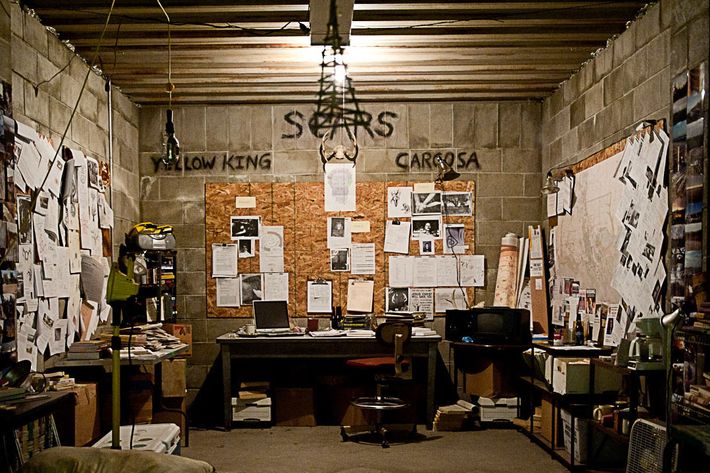
“The night before we shot there, Matthew camped out and painted some stuff. He had himself a vision quest,” DiGerlando said. That’s because the storage unit was the culmination of everything Cohle had drudged up between 1995 and 2012. To make sure the space was bursting with stuff, Reiss held photo shoots, hired artists, created books (like the one on how to build devil’s nests), worked up detailed documents and newspaper clippings — all to demonstrate years of obsession. “It’s not like you can call up an image library and say, ‘Give me all your pictures of dead bodies.’ We had to generate all that,” DiGerlando said, pointing to the weird occult paraphernalia, the photo of the girl with the horses, microfiche, photo copies, the yearbook, and all the stuff that had previously been in Rust’s apartment. “It should look like maybe Rust was around more than we thought he was, like he had in fact been working on this case for years.” And there’s an order to all of it. “He’s meticulous, so while it may look messy, everything is in place. There’s an area for the maps, an area for his photographs, things that inspire him. There’s even an area where he experiments with the construction of how he might make a devil’s nest.”
